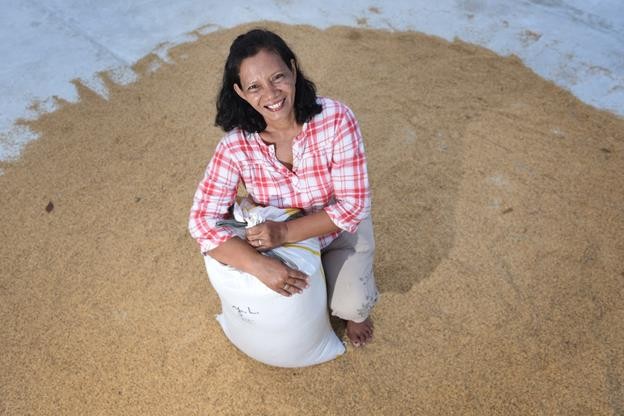
March 2016—Under the afternoon sun in the Philippines, harvested grain lays on a solar dryer before processing in a rice mill. Three feet away from the mounds of grain, Anna Grace Cabillo, secretary of the Kasaganahan Irrigators Association Inc., keeps watch.
Cabillo is a farmer in Palo, Leyte who benefitted from USAID’s agriculture support following Typhoon Haiyan. In November 2013, the strongest recorded typhoon to make landfall demolished the central region of the Philippines. Many people lost their lives and livelihoods, and farmers were not spared.
Wind and rain battered farmlands and ruined flatbed mechanical dryers, which were used for drying farmers’ palay (unprocessed rice) harvest. Unable to produce market-ready rice, farmers sold their palay at very low prices.
To help farmers recover, USAID, through its REBUILD project, partnered with rice farmer associations to install community solar dryers. This allowed farmers to dry their harvest, reap greater profits and deliver quality food to consumers.
“The solar grains dryer is a huge benefit,” said Cabillo. “After the typhoon, we had to place our grains on plastic tarps along the public roads, resulting in pilferage and poor quality of produce. Our safety was also a concern.”
Now situated far from the highway, the dryer draws famers from adjacent barangays (districts). Here, farmers dry their produce without worrying about its quality or their safety.
Since its inauguration in July 2015, the solar dryer has dried approximately 700 sacks of grains. USAID is also constructing 33 agri-fishery support facilities throughout the region to broaden the project’s impact.
The influx of agricultural activity is a welcome change for the association. Cabillo notes that the 292-member group is comprised of more than 200 females.
“People think farming is dominated by men, but it is the women who keep the association in order and afloat,” she said. “We track transactions, ensuring every grain is accounted for. We charge Php2.00 (4 cents) per sack of grain for members. and Php5.00 (11 cents) for non-members. We meticulously record these transactions. They may be small amounts but, collectively, these will go a long way towards helping us.”
The women of Kasaganahan are not afraid to get their hands dirty, too. The association's men and women get lost in a coordinated rhythm while they collect the dried grain into sacks using makeshift wooden rakes. As they work together, they are almost indistinguishable from each other.
“Anything men can do, we can do,” said Cabillo with confidence. “We harvest alongside our male counterparts. This way, we can do more in less time. Our success was possible because males and females saw each other as equals. We take great pride in complementing each other’s strengths and weaknesses.”
To help families recover from Typhoon Haiyan, the U.S. Government, through USAID, is working with the Government of the Philippines to rebuild schools, sari-sari (small kiosks) stores and health centers. USAID also launched livelihood programs to help people start earning a decent living again. To date, the U.S. Government has provided nearly $143 million to help typhoon survivors build back better.
LINKS
Follow @USAID_Manila, on Facebook, on Flickr, on YouTube







Comment
Make a general inquiry or suggest an improvement.